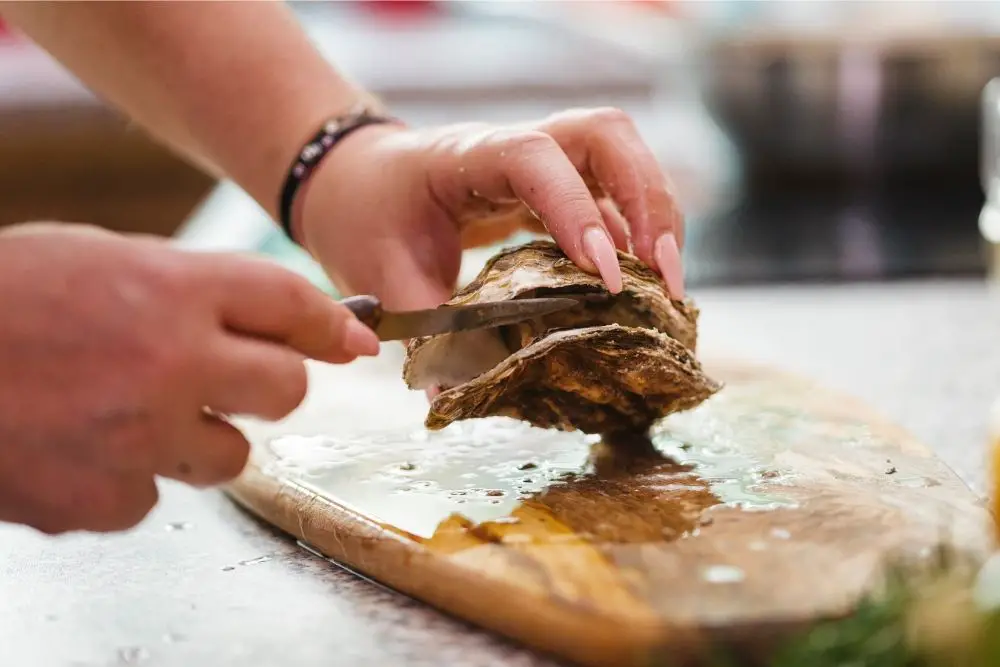Disclosure: Thank you for reading our articles! Some links may be affiliate links. We may get paid if you buy something or take an action after clicking one of these links. Additionally, as an Amazon Associate, I earn from qualifying purchases.
You need to clean oysters before you shuck and eat them. For as long as we have been eating oysters, we’ve been devising ways to separate the dirt, mud, and grime from the sealed oyster shells.
Many cooking recipes for oysters require them to be cooked in or with their shells, so the shells have to be clean before you can do that. Raw oysters are often served in their half-shell, so they need to be clean if coming into contact with your mouth.

To clean and shuck an oyster, you’ll need the following:
- Oysters
- A bowl or a colander
- A sink
- Crushed ice (optional)
- A towel or a protective glove
- A scrub brush
- An oyster-shucking knife
From here, some leave their oysters in a small bowl of icy water for a short while, about eight to ten minutes.
During that time, there should be sand and other specks of dirt visible at the bottom of the bowl. That’s how you know it’s working.
It also softens the dirt and debris that’s still attached to the shell, making it easier to scrub off with a brush.
To scrub, you’ll likely need to hold it, which we’d recommend doing with a towel or a protective glove so you don’t cut your fingers.
Others prefer to use moving water, so they place the oysters in crushed ice inside a colander and then run tap water through it. This has the same effect, softening dirt so you can scrub it all away.
You may also need to make sure the inside of the oysters is clean, which means shucking them.
Using the towel or glove to keep your hand safe, you hold the oyster in that hand and the knife in your dominant one.
Bury your knife into the back hinge, making sure that the cup is down. Don’t push in too far so you don’t harm the meat.
Twist and lift the knife to the right and the shell should be split. Then you drag the knife along the bottom of the detached shell to separate the connective tissue.
Throughout the process, try to minimize liquid spillage and keep shell chips out of the meat.
Inspect the interior and the meat of the oyster to make sure it’s clean. Any crushed ice left is great for serving freshly shucked oysters on but don’t let them sit for more than thirty minutes if intending to eat fresh.
How to Clean Fresh Oysters
When you clean oysters, you should start with the freshest oysters available to you.
If you’re in a place where you can find oysters yourself, in places where they won’t be contaminated with bacteria.
As always, stay away from the open ones as they’re dead and contaminated by bacteria from both outside the shell and inside decomposition.
Remember to tap them, a live oyster will snap shut and still be good for eating.
How to Clean Oysters Before Cooking
You’re cleaning your oysters for a reason, to make them safe and hygienic to eat.
While you can eat oysters raw, some prefer them cooked, especially if they’re pre-shucked oysters that have lost some freshness but are still great when prepared correctly.
If you’re working with shelled oysters, they’ll be dirty and slightly muddy from the salty under-sea environments where they’re found. Cleaning those is simple, you just place them in a colander and rinse them under cold water.
Some also like to cover them with ice because this makes them easier to scrub the grime away. Sometimes this requires a toothbrush or a firm scrub brush to properly remove dirt.
If they’re from a jar, they’ve likely been stored in clean water and not oyster juice. There’s little use for that juice while cooking so a simple rinse of the shucked oysters will do before you start preparing them for cooking.
As for the cooking, you can then steam, bake, oven-roast, or grill the oysters.
Steaming is the easiest and guaranteed to be tasty if you enjoy oysters. Baking and oven-roasting are easy too, requiring only your oven, and grilling is an ideal way to cook oysters when they’re still in their shells.
Pre-shucked oysters can also be fried if you can make breadcrumbs. This allows you to factor in all sorts of flavorings that can make the oysters even tastier.
How to Clean Oysters in the Shell
When cleaning oysters, it’s the shell that gets cleaned instead of the interior. The only time that the interior of the shell will need cleaning is where sand particulate or broken shell has found its way onto the oyster meat.
If you’d like, you can completely remove the oyster meat and rinse it but then you’ll lose the liquor inside the shell, so pre-shucked oysters would be more appropriate.
The surest way to clean the actual oyster meat is to cook it. While oyster is enjoyed raw often, and it’s safe for many, there can still be bacteria or viruses that go unnoticed.
They don’t give off the telltale signs of an oyster going bad with age, like a look or a smell. You can contract norovirus, Vibrio parahaemolyticus, or Vibrio vulnificus from eating raw oysters.
Cases of norovirus and vibriosis in North America are a common occurrence. Salmonella has also been found, as has hepatitis A.
The risk is tiny when eating oysters raw but they’re relatively zero if the oyster is cooked. If you’re concerned about the cleanliness of the oyster meat for whatever reason, you should roast, bake, fry, or broil them.
You can do a lot with oysters and, by opting to cook them, you can add lots of different flavorings that you don’t get with raw servings.
How to Clean Oysters for Grilling
Grilling oysters is a great way to bypass the shucking process and end up with a smoky treat at the end of it.
If you’re putting the whole oyster into the grill, then you need to wash them beforehand. The washing process can be as rigorous as you want it to be.
A bowl of cold water will suffice in removing dirt and sand particles but, with more stubborn grime, an ice bath and some heavy scrubbing may be necessary.
Any oyster can be grilled but the larger the better, and they’re also easier to clean since there are fewer hard-to-reach places.
Grilling oysters is enough to open them after around ten minutes, so many swear by grilling as a way of opening them.
It should also be noted that cooking oysters will kill most bacteria that are remaining on the shells after cleaning, so grilling can be a cleaning process in and of itself.
If the oysters are already shucked, you can place them on a baking sheet or directly on the grate, where they should be shell-side down.
This helps annihilate any potential bacteria on the interior of the oyster too, though there should be none if freshly shucked.
For extra flavoring, throw some herbs of your choice and some butter on top of the oysters.
Cover the baking sheet with foil if it’s deep enough. After five minutes, the oysters should start simmering in their shells. This means they are ready to eat.
